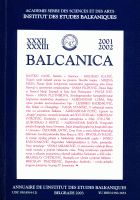Knežinska i seoska samouprava u Srbiji 1739–1788
Principal and Village Self-Government in Serbia 1739-1788
Author(s): Miroslav SvirčevićSubject(s): History
Published by: Balkanološki institut - Srpska akademija nauka i umetnosti
Keywords: Serbia; self-government; Belgrade; Ottoman authority; Austria-Turkish war;
Summary/Abstract: In Serbia, for the most part of 18th century, and more precisely from the conclusion of the Belgrade peace treaty in 1739, and re-institution of the Ottoman authority, until the break out of the new Austria-Turkish war in 1788, a new system of principal and village self-government was put in place, in accordance with the model from previous times. The Ottoman state stopped at nahija (nahiya) level. That was the smallest Turkish administrative and territorial unit, with muselim and kadija (kadiya) as the representatives of the Turkish authorities. In smaller local units, in principals (knezina) and villages, bodies of self-government were instituted. In the principals: principal assembly and principal prince. In the villages: village prince, villeins (kmetovi), and village assembly. The scope of their activities narrowed down to the activities of self-government, as well as certain state –related activities delegated to them by Turkish authorities. This is not disputed in literature. The disputes arise when it comes to identifying the principal (knezina). There are two major standpoints. According to the first one, the knezina is none other than the continuation of tribal institution. According to the other, the knezina has certain similarities to the tribe, but cannot be identified with it, since significant differences are in place. Taking this into consideration, the latter view is closer to truth. However, the system of principal and village self-government lasted until the Austro-Turkish war in 1788, when the Serbs fought on the side of Austria. Their armed movement was known under the name of “Kocina krajina” (Koca’s Frontier). The war ended in Sistova peace treaty in 1791, confirming the borders defined by the Belgrade peace treaty. Local self-government was re-instated in Serbia. Sultan Selim III, with special fermans 1893-1794, confirmed the self-government concessions granted to Serbia, which were a form of true autonomy. Therefore the Belgrade pashaluk gained autonomy, similar to that in other areas of the Ottoman Empire. Nevertheless, this issue is of special significance, and therefore requires further elaboration and consideration.
Journal: BALCANICA
- Issue Year: 2001
- Issue No: 32+33
- Page Range: 183-197
- Page Count: 14
- Language: Serbian

